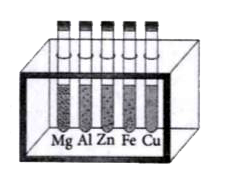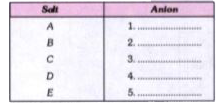Draw the diagram o l arrangement ofapparatus ued to show the reaction of zinc granules with dilute sulphurie acid and testing hydrogen gas by burning. Lable the following parts.
i) Soap solution. Ii) Delivery tube.
Similar Questions
In the laboratory preparation of hydrochloric acid , hydrogen chloride gas is dissolved in water .
(i) Draw a diagram to show the arrangement used for the absorption of HCl gas in water.
(ii) State why such an arrangement is necessary . Give two reasons for the same .
(iii) Write balanced chemical equations for the laboratory preparation of HCl gas when the reactants are :
A below 200∘C
B above 200∘C
View SolutionAluminium dissovles in mineral acids and aqueous alkalies and thus shows amphoteric character. A place of aluminum foil is treated with dilute hydrochloric acid or dilute sodium hydroxide solution in a test tube and on bringing a burning match stick near the mouth of the test tube, a pop sound indicates the evolution of hydrogen gas. The same activity when performed with concentrated with concentrated nitric acid. reaction doesn't proceed. Expalin the reason.
View Solution
Knowledge Check
Clean small pieces of magnesium, zinc, aluminium, iron and copper by rubbing them with a piece of sand paper. Take them in separate test tubes. Add about 10 mL of dilute hydrochloric acid to each of them.

Consider the following statements.
(i) The rate of evolution of hydrogen gas bubbles is not same in all the test tubes.
(ii) The rate of formation of bubbles is the fastest in the case of magnesium.
(iii) The reactivity decreases in the order:
Mg>Zn>Al>Fe>Cu.
(iv) In the case of copper, no bubbles are seen and the temperature also remains unchanged. This shows that copper does not react with dilute HCl.
Identify the correct option.AOnly (i) and (iv)BOnly (iii) and (iv)COnly (iii)DOnly (i), (ii) and (iv)
Aluminium dissovles in mineral acids and aqueous alkalies and thus shows amphoteric character. A place of aluminum foil is treated with dilute hydrochloric acid or dilute sodium hydroxide solution in a test tube and on bringing a burning match stick near the mouth of the test tube, a pop sound indicates the evolution of hydrogen gas. The same activity when performed with concentrated with concentrated nitric acid. reaction doesn't proceed. Expalin the reason.
View SolutionIdentify the anion present in the following compounds:
i] Compound X on heating with copper turnings & conc. sulphuric acid liberates a reddish brown gas.
ii] When a solution of compound Y is treated with silver nitrate solution a white precipitate is obtained which is soluble in excess of ammonium hydroxide solution.
iii] Compound Z which on reacting with dilute sulphuric acid liberates a gas which turns lime water milky, but the gas has no effect on acidified potassium dichromate solution.
iv] Compound L on reacting with barium chloride solution gives a white precipitate insoluble in dilute hydrochloric acid or dilute nitric acid.
View SolutionIdentify the type of reactions on the basis of following observations:
In a test tube filled with dilute sulphuric acid, adding small Mg ribbon piece results in brisk effervescence & evolution of hydrogen gas.
View SolutionAluminium dissolves in mineral acids and aqueous alkalies and thus shows amphoteric character. A piece of aluminium foil is treated with diluted hydrochloric acid or dilute sodium hydroxide solution in a test tube and on bringing a buring matchstick near the mouth of the test tube, a pop sound indicates the volution of hydrogen gas.
The same activity when performed with concentrated nitric acid, reaction doesn't proceed. Explain the reason.
View SolutionAluminium dissovles in mineral acids and aqueous alkalies and thus shows amphoteric character. A place of aluminum foil is treated with dilute hydrochloric acid or dilute sodium hydroxide solution in a test tube and on bringing a burning match stick near the mouth of the test tube, a pop sound indicates the evolution of hydrogen gas. The same activity when performed with concentrated with concentrated nitric acid. reaction doesn't proceed. Expalin the reason.
View SolutionSalts A, B, C, D and E undergo reactions (i) to (v) respectively. Identify the anion present in these salts on the basis of these reactions. Tabulate your answers in the format given below:
(i) When silver nitrate solution is added to a solution of A, a white precipitate, insoluble in dilute nitric acid, is formed.
(ii) Addition of dilute hydrochloric acid to B produces a gas which turns lead acetate paper black.
(iii) When a freshly prepared solution of ferrous sulphate is added to a solution of C and concentrated sulphuric acid is gently poured from the side of the test-tube, a brown ring is formed.
(iv) When dilute sulphuric acid is added to D a gas is produced which turns acidified potassium dichromate solution from orange to green.
(v) Addition of dilute hydrochloric acid to E produces an effervescence. The gas produced turns lime water milky but does not affect acidified potassium dichromate solution.

View SolutionTo verify the law of conservation of mass in a chemicl reaction four students A,B,C and D perfored the following chemicla reactions in the schoold laboratory.
Added zinc granules to dil hydorchlorica acid
(b) heated lead nitrate (solid) in a test tube
(c ) dipped mg ribbon in copper suphate solution
(d) added barium chloride solution to sodium suphate solution .
Which student according to you is likely to obtain the best results and why?
View Solution

